Investor Day Key Points
Fung Global Retail & Technology attended VF Corp.’s 2017 Investor Day in Boston on March 30. We heard from:
Steve Rendle,
President & CEO
Doug Palladini, G
lobal Brand President, Vans
Arne Arens, G
eneral Manager, Americas, The North Face
Jim Pisani, Global Brand President, Timberland
Aidan O’Meara, VP & Group President, VF International
Kevin Bailey, President, Asia Pacific Region
Martino Scabbia Guerrini, President, EMEA Region
Scott Baxter, VP & Group President, Outdoor & Action Sports, Americas
Tom Waldron, President, Wrangler
Curt Holtz, President, Workwear, Jeanswear & Sportswear Brands
Greg Pulsifer, VP, Digital
Scott Roe, CFO
Ahead of the meeting, VF Corp. outlined its five-year strategic growth plans. Revenues through 2021 are expected to grow at a mid-single-digit CAGR, driven by growth in the company’s largest brands (Vans, The North Face and Timberland) as well as by international expansion and the direct-to-consumer businesses.
Expected Revenue CAGR through 2021
By Region
 By Channel
By Channel

Earnings are expected to grow at a five-year CAGR of
10%–12%. That is based on a gross margin of 51.5%, an operating margin of
16.0% and ROIC in excess of 20% in 2021.
The company also targets top quartile shareholder returns in the range of
13%–15%. The five-year plan addresses the rapidly changing retail landscape and focuses on four key elements:
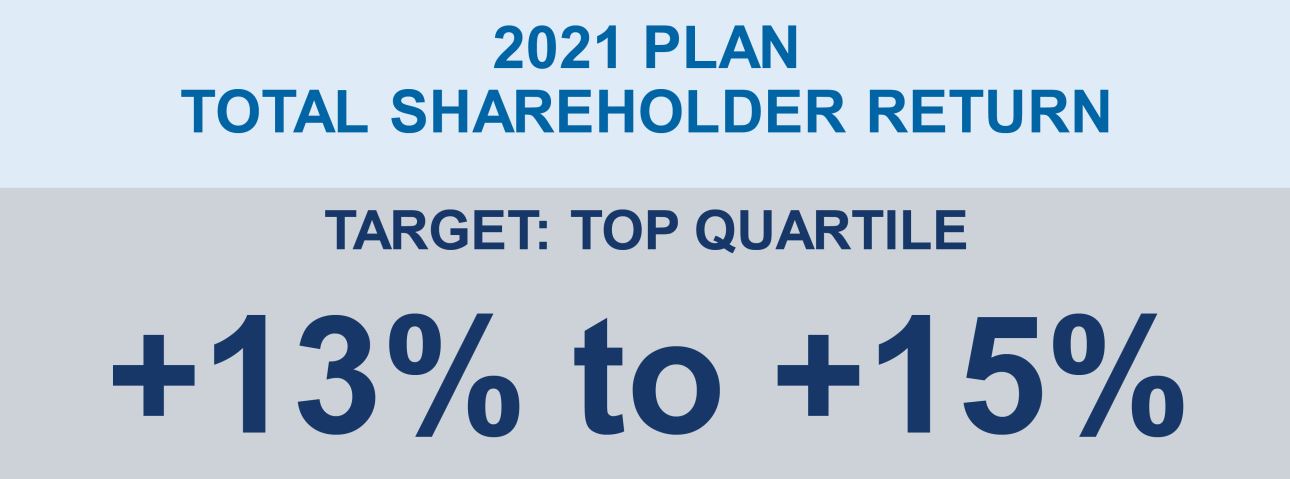 Source: vfc.com
Source: vfc.com
- Reshaping the company’s brand portfolio and enabling growth of the company’s brands
- Transforming to a consumer- and retail-centric model
- Elevating the direct-to-consumer channel, while prioritizing digital channels
- Distorting investment toward Asia, and China in particular
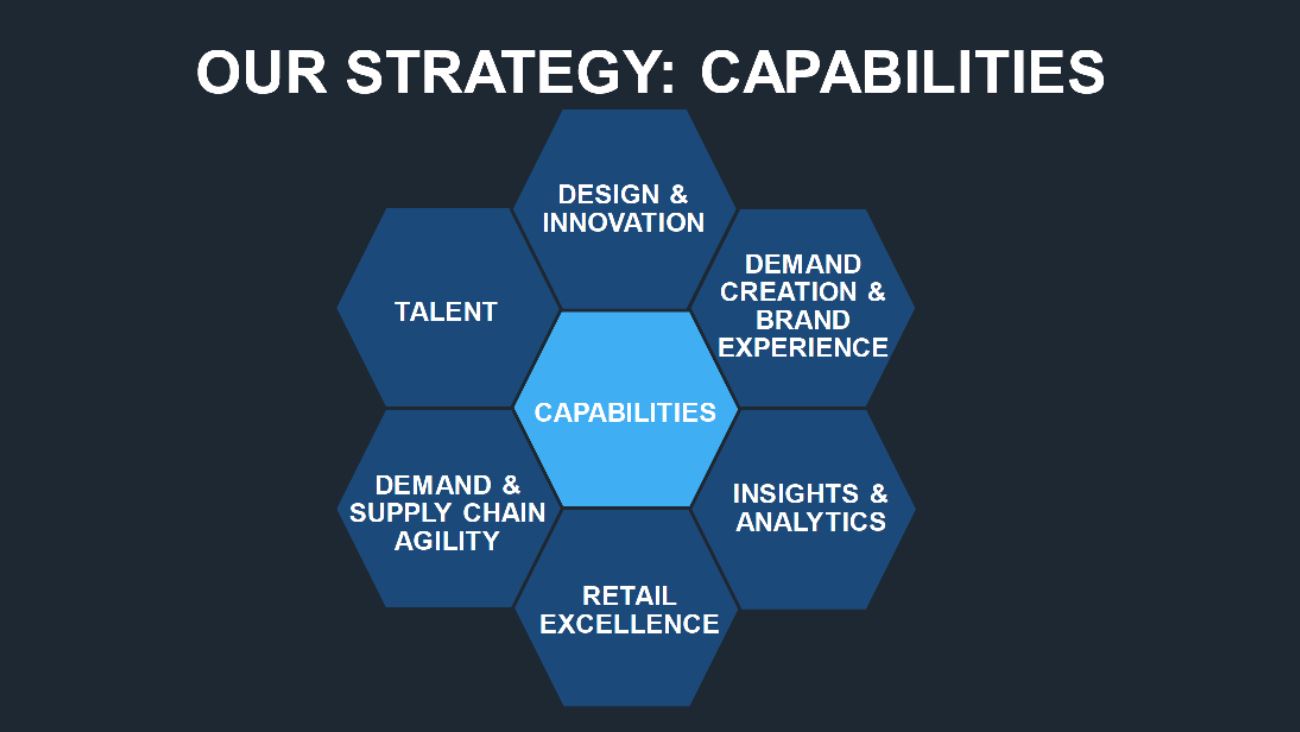 Source: vfc.com
Source: vfc.com
- Design and innovation
- Demand creation and brand experience
- Insights and analytics
- Retail excellence
- Demand and supply chain agility
- Talent
These themes recurred across the various presentations given throughout the day and were consistent across the company’s different brands. Of particular note was the theme of design and innovation: VF Corp. management and management at each specific brand talked about curating and creating products that consumers covet and cannot live without. To create such products, the company must manage the product lifecycle. Management noted that it has elevated the focus on design.
Management also noted that even though the company has not made an acquisition since it acquired Timberland in 2011, it is open to acquisitions that would be accretive in the near term and would drive incremental upside to its five-year plan.
Below, are key points from the individual brand presentations.
Vans: Ubiquity is not Vans
Doug Palladini, Global Brand President, talked about the Vans business. He said the brand is expected to generate a sales CAGR of 8%–10% over the next five years. Similar to VF Corp.’s other brands, Vans expects growth to be driven by international markets and the direct-to-consumer business (particlarly digital), with the apparel category leading the growth.
Vans plans to drive growth by innovating in its existing business, expanding the direct-to-consumer business, expanding into Asia and developing deep connections with consumers.
- Innovation will be driven by newness in footwear, which is expected to represent 30% of the business in 2021. Apparel and accessories are also a growing focus as the company works on becoming a head-to-toe brand.
- The direct-to-consumer channel is projected to account for 57% of total sales in 2021, up from 48% currently, with much of the growth coming from the digital channel. Digital is expected to account for 16% of sales in 2021, up from 7% in 2016 and 3% in 2012. On the digital side, the company is focused on blending the experiential with the transactional and giving consumers a compelling experience. The brand now offers a site where consumers can customize their own pair of Vans. The offering has resulted in a significant increase in page views and will be expanded to Canada and the EMEA and Asia-Pacific regions later this year.
- China is projected to represent 11% of sales in 2021, up from 7% in 2016 and 3% in 2012. While Vans is underrepresented in Asia compared with its competitors, the company believes the stores it does have perform better and are more productive than their competitive set. The brand’s approach to digital in China is to make sure it is localized and to leverage existing platforms by engaging customers where they are.
- In terms of driving consumer connectivity, Vans drives brand love and demand by bringing the brand to life. Steeped in heritage and authenticity, the brand is very clear about what it is and what it is not—and it is transparent about the fact that Vans is not for everyone. The brand offers a strong point of view and a clear story.
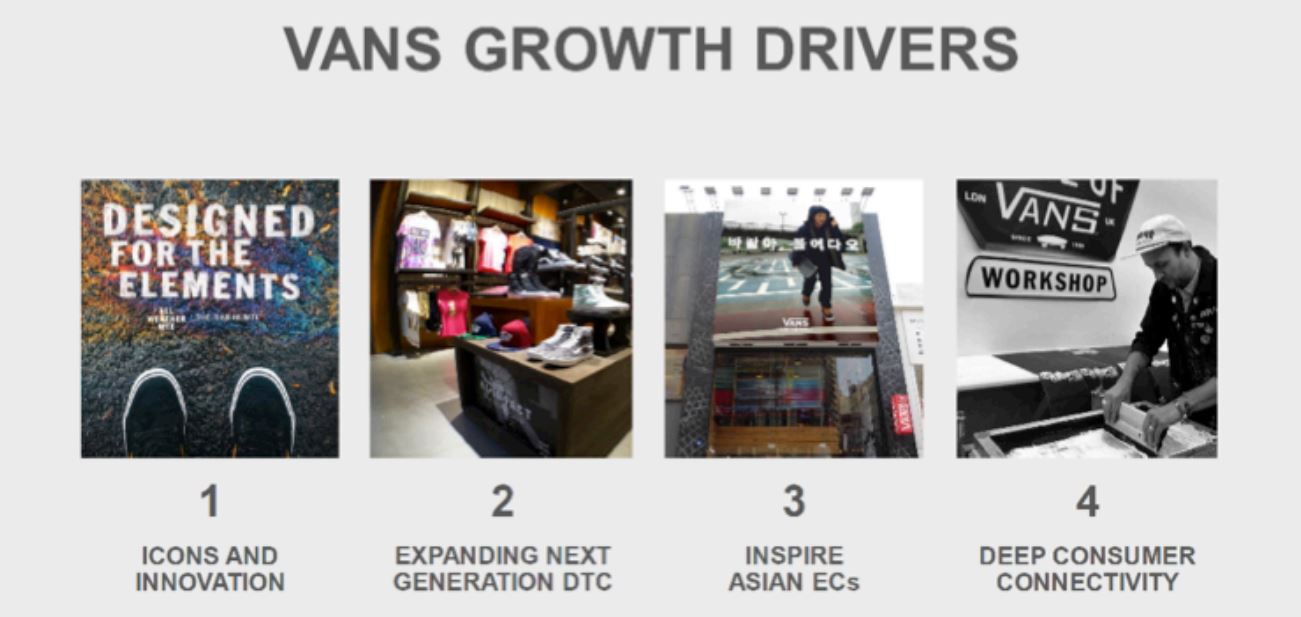 Source: vfc.com
Source: vfc.com
While Vans’ history is in the skate category, the brand views itself as a connector across many forms of creative expression: music, art, street culture and action sports. The core consumer the brand targets is the “expressive creator,” a consumer at the leading edge of style. While that group on its own represents 12% of the $83 billion footwear and apparel market, it also impacts “halo consumer” trends and style, and halo consumers represent 28% of the market. Finally, the expressive creators influence the “relevant consumers” that make up 69% of the market. Vans currently has a 5% share of the footwear market and a 1% share of the apparel market.
The North Face: Focused on Attracting New Consumers, Lessening Seasonality and Solidfying Mountain Sports Leadership
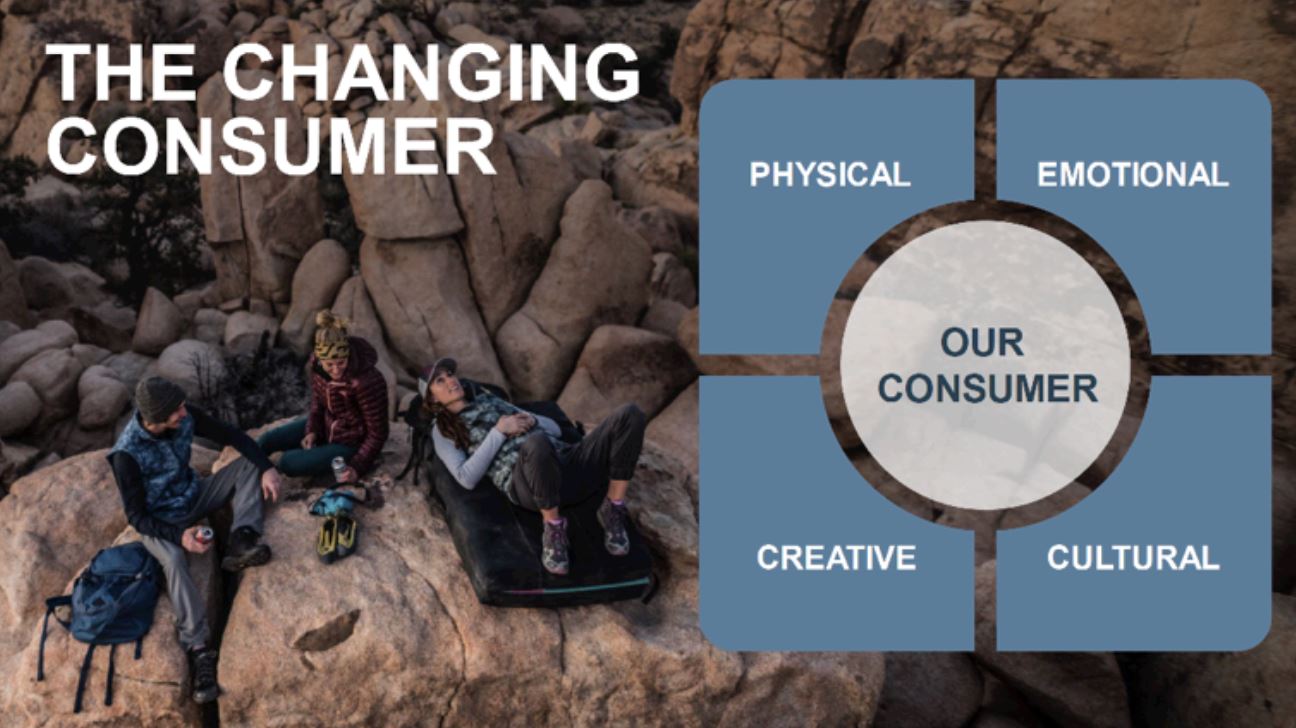
Source: vfc.com
Arne Arens, General Manager, Americas, discussed The North Face brand. While some external factors, such as a more promotional environment and unseasonable weather, weighed on the brand in the last couple of years, there were also internal factors that hampered results, he said, including a slowdown in newness and innovation.
Arens said that the company’s two keys to success were new and innovative products and an expansive, consumer-focused vision. The latter drove the company’s “consumer territory” model, which breaks down into four categories: mountain sports, mountain athletics, mountain lifestyle and urban exploration.
- Mountain sports is the core of the brand and the largest part of the business. The category targets elite-level participants in sports and outdoor adventures.
- Mountain athletics represents the day-to-day training that enables an elite level of performance as well as the running category and general fitness. The category represents more significant growth, as The North Face has less than a 1% share in the category. Growth in mountain athletics would help improve year-round sales with increased sales in summer and spring.
- Mountain lifestyle is more of a category for the outdoor enthusiast; products include camping and other gear and apparel. The North Face is underpenetrated in this category, too, with a low-single-digit share of the market. Stronger sales in the category would also help improve seasonality.
- Urban exploration is a premium lifestyle category that targets urban dwellers who may not lead an outdoor lifestyle in the traditional sense. With urbanizaton increasing, such consumers represent half the world’s population.
Sales over the next five years are expected to grow at 6%–8% CAGR. The North Face expects the mountain athletics category to grow the fastest, at an 11%–13% CAGR, followed by urban exploration at 9%–11%, mountain lifestyle at 8%–10% and mountain sports at 4%–6%.
Timberland: Expanding Outside the Core Category of Men’s Boots
Jim Pisani, Global Brand President, said the Timberland brand is focused on becoming the largest, most sustainable outdoor lifestyle brand. The company is no longer just a boot company; rather, it is focused on head-to-toe wardrobing.
 Source: vfc.com
Source: vfc.com
Timberland refers to its target customer as an “outdoor lifestyler” and says this customer is more casual, often based in an urban outdoor setting and that style matters to him, although versatility is key.
Timberland expects sales to grow at a 4%–6% CAGR to 2021. The brand’s three key growth drivers are diversifying beyond the core boot category, prioritizing digital and distorting investment toward Asia.
1) The brand sees significant market opportunity as it expands outside its core category of men’s footwear. Outside the core boot category, Timberland is focused on men’s shoes as well as on women’s footwear and men’s apparel. The global women’s footwear market is worth $141 billion, while men’s apparel is worth $217 billion and men’s footwear is worth $94 billion.
2) Elevating design and innovation will enable this diversification. Within footwear, Timberland is launching three new platforms in SensorFlex, Aerocore and classics reimagined.
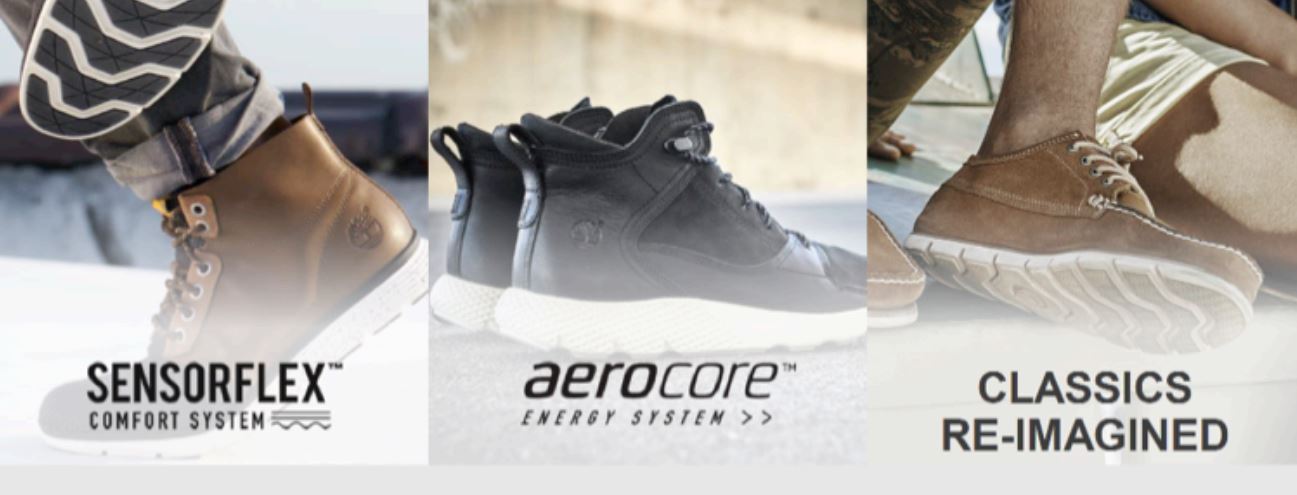 Source: vfc.com
Source: vfc.com
3) On the direct-to-consumer side, Timberland is increasingly focusing on the women’s business, adding women’s shops-in-shops and experiential components to the channel. Timberland is also prioritizing digital channels in both mobile and e-commerce.
4) Looking at Asia, the brand expects China to represent a relevant market of $200 billion by 2021. On the product side, Timberland has a “footwear first” initiative that is locally driven. On the distribution side, it is adding stores with Chinese partners, growing its direct-to-consumer business and expanding its current partnerships. On the marketing side, the brand is focused on high-profile collaborations and sponsorships with influencers.
Wrangler: Leveraging Strengths to Drive Future Growth
Wrangler President Tom Waldron spoke about the Wrangler and Lee brands within the jeanswear category. The Lee brand was founded in 1889 by Henry David Lee as the H.D. Lee Mercantile Company, Waldron said. The brand is centered on purposeful craftsmanship and innovation.
In the EMEA region, the Lee brand is generating consistent growth and increasing its momentum. In the Asia-Pacific region, the brand’s growth is accelerating, thanks to innovation-led product platforms. In North America, the brand is revisiting its strategy.
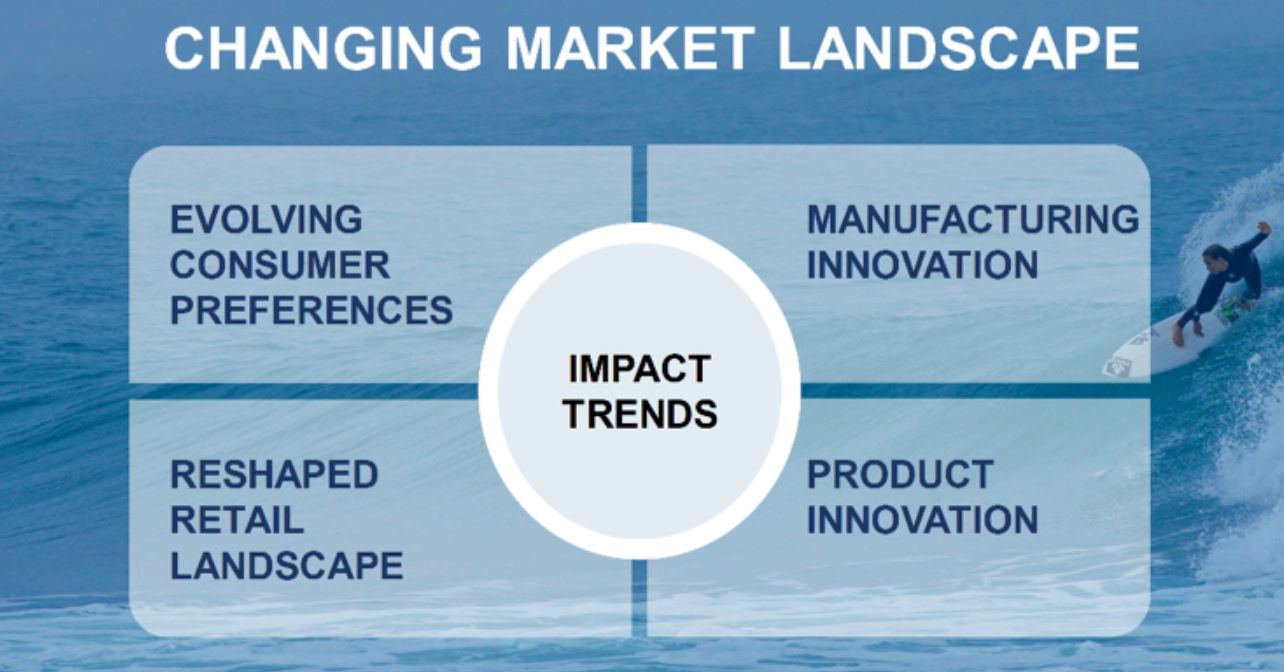
Source: vfc.com
The Wrangler brand heritage is “cowboy jeans for cowboys.” Wrangler has performed slightly better than Lee over the most recent five-year period, growing at a 3% CAGR and gaining market share, even as the US denim category fell by 0.5% over the period.
The jeanswear segment (Wrangler and Lee) is expected to grow at a 1%–3% CAGR over the next five years. Wrangler expects to drive growth by establishing “one Wrangler,” elevating design and innovation, expanding into new channels and growing in new categories.
1) Historically, Wrangler has focused on the mass consumer and Western consumer segments. The “one Wrangler” idea incorporates an organizational redesign into a consumer-focused business, elevating the brand with social and emotional brand messaging that is rooted in authenticity and adopting a consumer and lifestyle focus with a broadened appeal across distinct lifestyles.
2) In terms of product, the brand notes that it cannot just offer a beautiful product; it must offer a solution for consumers. The VF Global Denim Innovation Center is using consumer insights and innovation to achieve this.
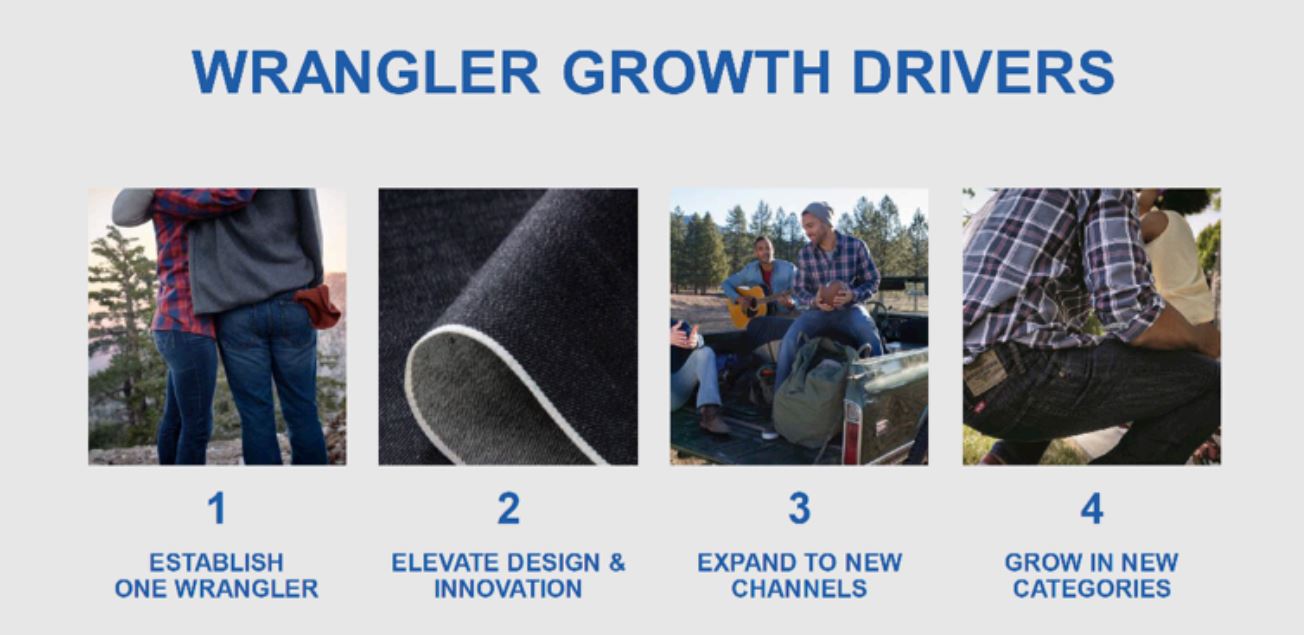
Source: vfc.com
3) The jeanswear segment has historically focused on the Western and mass consumer channels, and is therefore vastly underindexed in both mid-tier stores and department and specialty stores, according to Wrangler. The company launched in mid-tier channels between 2010 and 2015, and in department and specialty stores more recently. Jeanswear has seen success in terms of sales volume, and where the product is available, it is selling, which gives management confidence in terms of entering new channels. Retro collections and celebrity seedings will enable success in these new channels, according to management.
4) One in four men in the US wears the Wrangler brand, and Wrangler is #1 in men’s denim, casual bottoms and woven tops. The company believes that its dominance presents an opportunity for new Wrangler categories, particularly given that the brand is present in only a fraction of the market regionally. New categories include women’s denim (a $10 billion market), men’s woven tops (a $5 billion market), men’s knit tops (an $11 billion market) and non-denim bottoms (a $6 billion market).

 By Channel
By Channel Earnings are expected to grow at a five-year CAGR of 10%–12%. That is based on a gross margin of 51.5%, an operating margin of 16.0% and ROIC in excess of 20% in 2021.
The company also targets top quartile shareholder returns in the range of 13%–15%. The five-year plan addresses the rapidly changing retail landscape and focuses on four key elements:
Earnings are expected to grow at a five-year CAGR of 10%–12%. That is based on a gross margin of 51.5%, an operating margin of 16.0% and ROIC in excess of 20% in 2021.
The company also targets top quartile shareholder returns in the range of 13%–15%. The five-year plan addresses the rapidly changing retail landscape and focuses on four key elements:
 Source: vfc.com
Source: vfc.com Source: vfc.com
Source: vfc.com Source: vfc.com
Source: vfc.com
 Source: vfc.com
Source: vfc.com Source: vfc.com
Source: vfc.com
